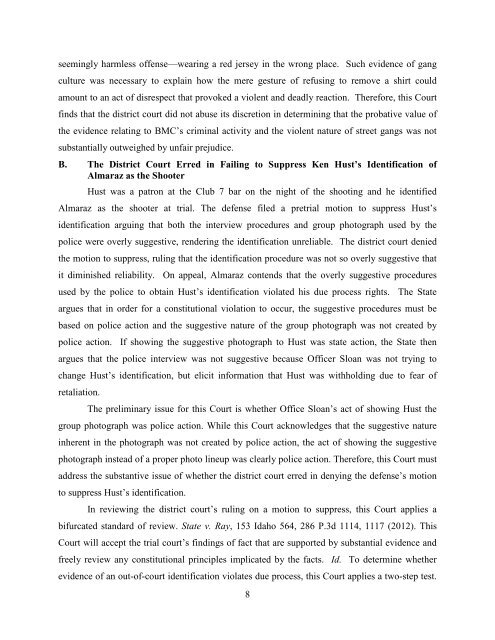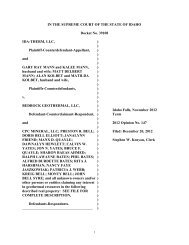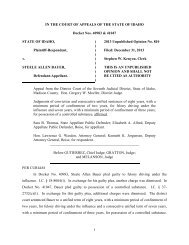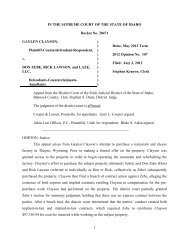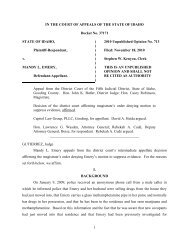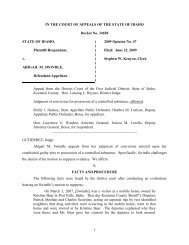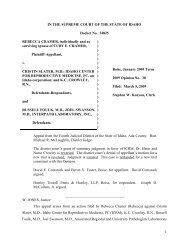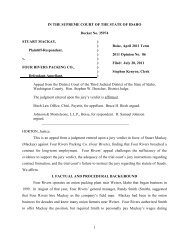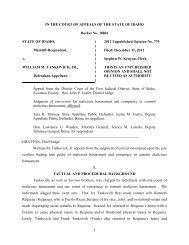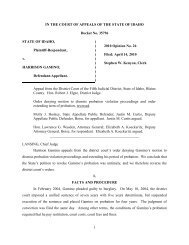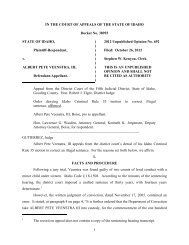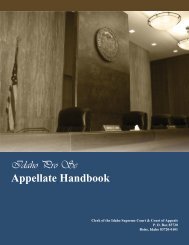April 1, 2013 State v. Hector B. Almaraz, Jr. - Idaho State Judiciary
April 1, 2013 State v. Hector B. Almaraz, Jr. - Idaho State Judiciary
April 1, 2013 State v. Hector B. Almaraz, Jr. - Idaho State Judiciary
Create successful ePaper yourself
Turn your PDF publications into a flip-book with our unique Google optimized e-Paper software.
seemingly harmless offense—wearing a red jersey in the wrong place. Such evidence of gang<br />
culture was necessary to explain how the mere gesture of refusing to remove a shirt could<br />
amount to an act of disrespect that provoked a violent and deadly reaction. Therefore, this Court<br />
finds that the district court did not abuse its discretion in determining that the probative value of<br />
the evidence relating to BMC’s criminal activity and the violent nature of street gangs was not<br />
substantially outweighed by unfair prejudice.<br />
B. The District Court Erred in Failing to Suppress Ken Hust’s Identification of<br />
<strong>Almaraz</strong> as the Shooter<br />
Hust was a patron at the Club 7 bar on the night of the shooting and he identified<br />
<strong>Almaraz</strong> as the shooter at trial. The defense filed a pretrial motion to suppress Hust’s<br />
identification arguing that both the interview procedures and group photograph used by the<br />
police were overly suggestive, rendering the identification unreliable. The district court denied<br />
the motion to suppress, ruling that the identification procedure was not so overly suggestive that<br />
it diminished reliability. On appeal, <strong>Almaraz</strong> contends that the overly suggestive procedures<br />
used by the police to obtain Hust’s identification violated his due process rights. The <strong>State</strong><br />
argues that in order for a constitutional violation to occur, the suggestive procedures must be<br />
based on police action and the suggestive nature of the group photograph was not created by<br />
police action. If showing the suggestive photograph to Hust was state action, the <strong>State</strong> then<br />
argues that the police interview was not suggestive because Officer Sloan was not trying to<br />
change Hust’s identification, but elicit information that Hust was withholding due to fear of<br />
retaliation.<br />
The preliminary issue for this Court is whether Office Sloan’s act of showing Hust the<br />
group photograph was police action. While this Court acknowledges that the suggestive nature<br />
inherent in the photograph was not created by police action, the act of showing the suggestive<br />
photograph instead of a proper photo lineup was clearly police action. Therefore, this Court must<br />
address the substantive issue of whether the district court erred in denying the defense’s motion<br />
to suppress Hust’s identification.<br />
In reviewing the district court’s ruling on a motion to suppress, this Court applies a<br />
bifurcated standard of review. <strong>State</strong> v. Ray, 153 <strong>Idaho</strong> 564, 286 P.3d 1114, 1117 (2012). This<br />
Court will accept the trial court’s findings of fact that are supported by substantial evidence and<br />
freely review any constitutional principles implicated by the facts. Id. To determine whether<br />
evidence of an out-of-court identification violates due process, this Court applies a two-step test.<br />
8


